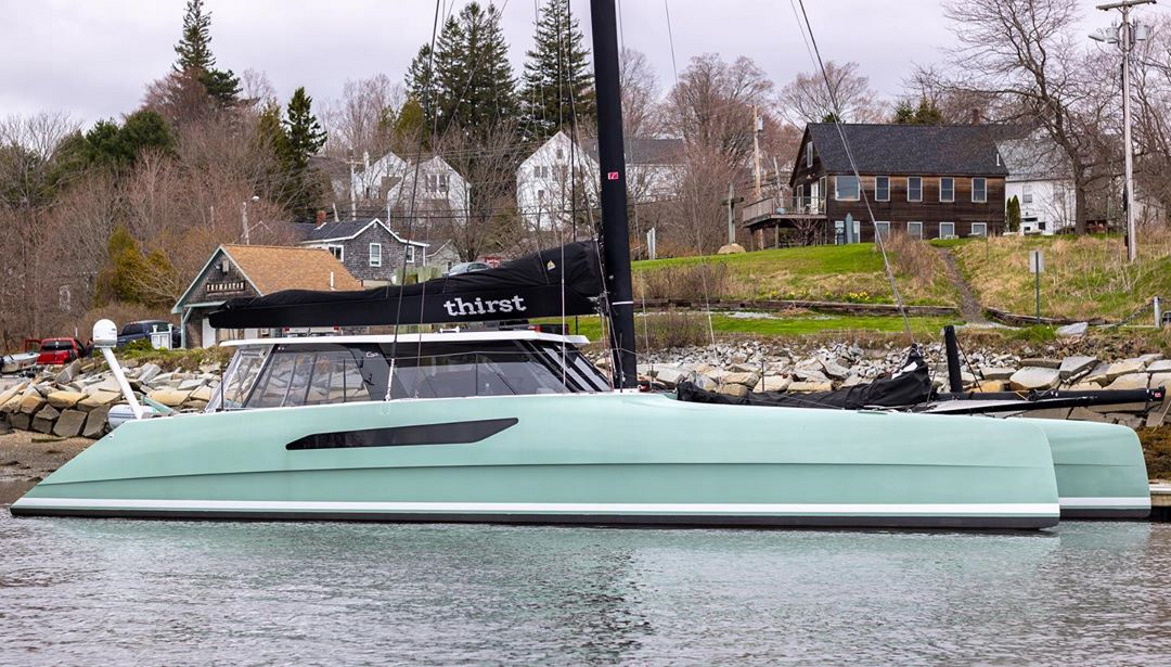
After a string of designs by Morrelli and Melvin, Gunboat founder Peter Johnstone picked up the phone and dialed the number of British racing cat designer Nigel Irens, and a new series of Gunboats was born. First came the 60 (manufactured in China) and then the Gunboat 55 was launched in the US following a dispute with Hudson Marine in Xiamen.
The British designer has pulled off a design that manages to look muscly and elegant at the same time. You could describe it as a kind of luxurious (and yes, more expensive) Atlantic 57 catamaran for warmer climes. I am sure they won´t mind me making a comparison to the classic Chris White design.
The 55s were the first Gunboats to be made in the US, in North Carolina. Previous models had been manufactured in South Africa and China. There were disputes with manufacturing partners (principally Hudson Marine) and the production was moved to the States.
Interestingly, this migration spawned a whole ecosytem of performance multihull manufacturers in those countries such as HH and Kinetic. In terms of length, this boat seems to have hit the sweet spot for short-handed larger yachts, going for the same LOA as the Outremer 55 – the new performance cruising design from the French manufacturer.
Photo Credits: Biraceweek and Lyman-Morse
As with all Gunboats, weight saving is a key part of the design – these boats were built along the same lines as an ocean racer. Hulls and deck are a composite of carbon fiber, epoxy resin and Corecell foam. The hulls and bridge are part of a single mold producing a very stiff structure that doesn´t require a forward crossbeam. Having said that, she´s heavier than a Catana 53 but carries a more powerful sail plan.
Pros
- Along with the 48, the 55 is the Gunboat model best set up for short-handed sailing.
- The forward working cockpit has been moved inside, just in front of the helm, so no more soakings in rough weather! It´s very organised, and you can hop up to the front deck from here if you need to.
- The whole of the covered upper deck is one open space. There are galley up boats and galley down that have even more space up top.
- Those centreboards are arguably safer than fixed daggerboards. If they hit anything, they will just pivot up, and by the time the 55 had launched, Gunboat had ironed out the initial teething problems they had with the boards on the 60.
- With the large window ahead of the helm slid open and that open back, the ventilation in this boat is second to none.
- The big red emergency release button by the helm means it is is easy to dump the mainsheet in a gust or squall.
- She´s light, stiff and fast. You should be sailing close to wind speed on most points of sail.
- The Gunboat 55 is the only model that was designed and built in the US. Now that´s not to say that the production quality was inferior elsewhere, but quality control had to be easier when the factory was on the doorstep.
Cons
- All of the 55s had to be extended to 57 foot after they had been launched due to some instability at speed that owners were experiencing. They solved the problem, but still, there was an initial fault with the design.
- The salon is open at the back. You can close this off with covers if the weather turns cold, but essentially the 55 was designed for blasting around the Carribbean and other warm destinations.
- Gunboat 55s are expensive as they don´t come onto the market very often. For the same kind of money, there is plenty of choice in this market – it´s pretty competitive. Kinetic and HH come to mind. Having said that, Gunboats hold their value: that´s the power of their brand, so you might even save money in the long run.
- The maintenance cost of these yachts is high, as they didn´t build many of them. That´s probably not going to worry you if you can afford to buy one in the first place.
Build
Carbon fiber was used for the Hall Spars mast and boom, and the interior furniture was built of carbon/Divynicell-foam composite panels. The Weight Police have been all over these boats, resulting in a weigh in of 12.5 tonnes unladen.
And instead of daggerboards, the 55 has centerboards that pivot flush into the hulls. You control them from the helm: a display indicates how deeply the boards are set. Gunboat 55s are actually 57´ long. 2 metres were added to the transoms as a retro fit to improve stability at speed.
On Deck
The 55 was launched with some real innovations on the deck and living space areas. This performance cat was designed for warmer climes, and she comes with an integrated saloon/cockpit area: the ultimate Open catamaran.
The whole area is connected into one seamless area protected on three sides by panoramic windows and open to aft. The saloon can be closed off with soft covers if the weather turns. A big sliding window in front of the cockpit helm and sailing station keeps the wind in your hair on fair days, and you can hop up from here onto foredeck and the nets. Above the helm, a sliding moonroof gives you a good view of the sails.
The whole boat has been organised for shorthanded sailing, albeit with the assumption that the skipper and crew are experienced. All the lines lead neatly into the forward cockpit which is sheltered in the forward part of the saloon. A pair of Lewmar 58 hydraulic winches are there to help you with the muscle work, with cam cleats and Spinlock clutches for the halyards, sheets, reefing lines and furling lines. The Harken mainsheet traveler runs along the aft crossbeam with the lines led forward.
The self tacking solent runs along a curved Harken track and the sheets are fed back to the control centre. It all smacks of Gunboat efficiency and is well thought out.
Down Below
Many of the 55s were built with just 2 luxury cabins- she´s targeted primarily at couples : the owner’s stateroom to port with a double berth athwartships so you can can look out of the window and another large double cabin in the starboard hull, with a heads/shower area and an aft cabin that can either be set up as a workshop, office or third stateroom.
Some of the boats built (such as Rainmaker) went for the galley down layout, set aft in the port hull. The other option was galley-up, replacing one of the sofas in the saloon/cockpit with an island with double sink.
The feel of these boats is luxurious but understated.
Sailing
Like any Gunboat, this catamaran really comes to life when you get the sails up.
The lines are super organised with all of the controls fed to the forward working cockpit at the base of the mast which has been moved inside, just forward of the central helm. From here, you can set, trim and reef the sails with the help of two electric Lewmar 58 winches. The self-tacking jib looks after itself once trimmed, and the mainsheet is trimmed and eased at the touch of a button. The main can be dumped at the touch of a red emergency button by the wheel.
Welcome to the GUNBOAT 55 Thirst from the US Virgin Islands to the Multihull fleet of Block Island Race Week.
Full entry list: https://t.co/C8uoHlW7Rr#BlockIslandRaceWeek #BIRW #BlockIsland #Sailing #Regatta #StormTrysail pic.twitter.com/zIRxnAgFCR
— BI Race Week (@BIRaceWeek) April 30, 2019
All of the gear on these boats is top quality. The mast is a carbon fibre T600 modulus made by Hall Spars. The boom, masthead and spreaders are also carbon. All the running rigging is low stretch Spectra or Dyneema.
This is a catamaran that requires careful handling. That square top main is big and powerful and you´ll need to ease the mainsheet quickly in gusts – but that´s easy to do with those hydraulic rams. If there is a time when you should reef early, it´s on a turbo cat like this one.
The aim is to fly the boat at speeds close to true wind speed and maintain double digit speeds consistently. You´ll become used to seeing rooster tails off the transoms in this boat.
Gunboat 55s – Where are They Now?
55-01 Rainmaker
(dismasted in a 70 knot squall, abandoned & adrift, later salvaged). Rainmaker has been relaunched by Multimarine Manufacturing in the UK as a power cat.
55-02 Vandal
55-03 Toccata
55-04 Jammy
55 Thirst
55-05 Vai Vai
Became Gunboat 57, “Vai Vai”. She was finished off outside the Gunboat yard after the company went into administration and now calls herself Gunboat 57-01
55-06 ?
55-07 ?
55-08 ?
55-09 Starr
Finished in 2017 by Crosswait Composites. This company is still offering to finish off the remaining molds.
55-10 to 12
Laid up?
Rainmaker (55-01) Relaunched as a Power Cat
Summary
Once again, Gunboat moved the bar with this design. She´s the last of the Peter Johnstone era, British designed and American made. Surely, still one of the most desirable Gunboats on the water.
FAQs
How much do Gunboat 55s cost?
Toccata (the #3 hull) came onto the market for just under $1.9 million. That should give you an idea of the ball park price. At least they are cheaper than Gunboat 68s! Given that they initially went on the market for around $2.4 million, you can see that they hold their value.
Who Designed and Manufactured the Gunboat 55?
The 55 was designed by Nigel Irens and manufactured in the US in Wanchese, on Roanoke Island, North Carolina.
What Happened to Rainmaker, Gunboat 55-01?
The first 55, Rainmaker, was dismasted in a 70-knot squall about 200 miles southeast of Cape Hatteras on the 30th January 2015. The crew, including owner Brian Cohen and his son, abandoned the boat and Rainmaker was salvaged later near Bermuda. It ended up at MultiMarine in the UK where they are relaunching her.
Specs & Gunboat 55 Vai Vai Video
Technical Specification
| Length Overall | 17.35m / 56.91´ |
|---|---|
| Power | 2 x 39 HP Yanmars |
| Water | 2x185.5 litres / 2x49 Gal |
| Fuel | 2x299 litres / 2 x 79 Gal |
| Draft (Boards up) | 0.61m / 2´ |
| Draft (Boards Down) | 2.8m / 9.2´ |
| Displacement (Light) | 15.25 tonnes / 27,558 lbs |
| Displacement (Max Load) | 15.25 tonnes / 33,620 lbs |
| Beam | 7.62m / 25´ |
Contact Katamarans
Share your details with us and we’ll be in touch to discuss further.
"*" indicates required fields

